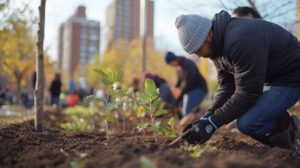Every year, Earth Day reminds us of our collective responsibility to protect our planet and ensure a sustainable future for all. Celebrated on April 22nd, this global event brings together communities, organizations, and individuals to address environmental challenges, from plastic pollution to climate change. Understanding the significance of Earth Day and the critical issues it highlights is essential for fostering a healthier, more sustainable world.
Today, in line with Earth Day and Earth Month this April, we’re exploring the impact of climate change on homeless populations. Read on to learn more about this complex interplay — and to find out what you can do to support people experiencing homelessness on Earth Day and beyond.
The Importance of Earth Day
Earth Day originated in 1970, at a time when industrial development and lack of environmental regulations led to widespread pollution and environmental degradation. This day was established to raise public awareness about environmental issues and has since evolved into a global movement that encourages positive action for the planet. Earth Day serves as a reminder of the urgent need to address environmental challenges such as climate change, which poses one of the greatest threats to our survival and well-being.
Climate Change and Homelessness
People experiencing personas sin hogar are among the most affected by climate change, facing immediate and severe consequences due to their vulnerable living conditions. Extreme weather events — including heat waves, floods, and storms — disproportionately impact those without shelter, putting them at greater risk of health issues, injury, or death. Climate change exacerbates these weather patterns, increasing their frequency and intensity, and thus posing an ever-growing threat to the homeless population.
The Immediate Impact
For people without homes, extreme temperatures can be particularly deadly. Without access to shelter, air conditioning, or heating, homeless individuals are directly exposed to the elements. During heatwaves, the risk of heat-related illnesses such as heatstroke and dehydration significantly increases. Conversely, cold snaps can lead to hypothermia and frostbite. Climate change amplifies these temperature extremes, making safe shelter more critical than ever.
The Future Outlook
As climate change progresses, we can expect these challenges to intensify. Rising sea levels and increased frequency of extreme weather events will not only threaten coastal communities but will also lead to more displacement, increasing the homeless population. Urban areas, already struggling with housing crises, will face additional pressures, making it even harder for vulnerable populations to find stable shelter.
How to Support People Experiencing Homelessness
Addressing the impact of climate change on populations of people experiencing homelessness requires a multifaceted approach. Supporting organizations that aid those experiencing homelessness is a vital part of this effort. Here at Crisis House, for example, we offer a range of services to support individuals and families experiencing homelessness, from emergency shelter to long-term housing solutions. Support our work by donating or volunteering to provide direct assistance to those in need!
Advocating for Climate Change Policies
Another critical way to support vulnerable populations in the context of climate change is through advocacy. Supporting policies that aim to reduce greenhouse gas emissions and promote sustainable development can mitigate the worst effects of climate change. By advocating for such policies, we can help protect not only our environment but also those who are most at risk from its impacts.
Practical Support
In addition to policy advocacy and supporting organizations like Crisis House, there are practical ways to assist homeless individuals during extreme weather events:
-
Emergency kits: Providing emergency kits with water, sunscreen, hats, and warm clothing can offer immediate relief during extreme weather conditions.
-
Awareness and education: Raising awareness about the risks of extreme weather and educating homeless individuals on ways to stay safe can be life-saving.
-
Shelter initiatives: Supporting initiatives that increase the availability of emergency shelters during heatwaves and cold snaps can provide a crucial refuge for those without homes.
Earth Day serves as a poignant reminder of our shared responsibility to protect our planet and its most vulnerable inhabitants. By supporting organizations like Crisis House, advocating for effective climate policies, and providing practical assistance, we can make a difference in the lives of those affected by homelessness in the face of a changing climate. Let’s take action today to create a more inclusive, sustainable, and resilient future for all.
En Crisis House, we are here during these stressful times to support individuals and families with our services and resources. We’re leaders in critical services in East County, San Diego, providing crisis intervention, transitional and permanent housing, and services for families and children fleeing domestic violence.
Ayúdenos a llegar a los necesitados by donating or volunteering today! You can also sign up for our newsletter to stay in the loop as we work to connect families, children, and individuals to crucial resources. Together, we can empower people to renew their lives!







